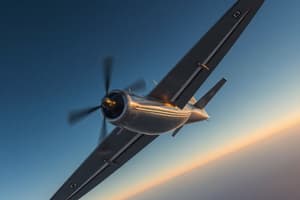Podcast
Questions and Answers
What is the primary reason for the reduction in aircraft lift and engine power on a hot day?
What is the primary reason for the reduction in aircraft lift and engine power on a hot day?
- Increased air density due to water vapor
- Decreased air density due to high temperature (correct)
- Changes in air pressure due to weather conditions
- Increased humidity due to atmospheric conditions
What is the effect of high humidity on air density?
What is the effect of high humidity on air density?
- It decreases air density by making the air lighter (correct)
- It has no effect on air density
- It increases air density by making the air heavier
- It changes the air pressure but not the air density
What is the purpose of an altimeter in an aircraft?
What is the purpose of an altimeter in an aircraft?
- To calculate fuel consumption
- To indicate the vertical speed of the aircraft
- To monitor air pressure and altitude (correct)
- To measure airspeed
What is the primary factor that affects air density, according to the content?
What is the primary factor that affects air density, according to the content?
What is the result of the combined effects of pressure, temperature, and humidity on air density?
What is the result of the combined effects of pressure, temperature, and humidity on air density?
What is the primary consequence of ignoring the effects of temperature, pressure, and humidity on air density?
What is the primary consequence of ignoring the effects of temperature, pressure, and humidity on air density?
What is the primary reason for pilots to adjust their performance calculations on a hot day?
What is the primary reason for pilots to adjust their performance calculations on a hot day?
What is the primary benefit of understanding the effects of temperature, pressure, and humidity on air density?
What is the primary benefit of understanding the effects of temperature, pressure, and humidity on air density?
What is the primary purpose of the airspeed indicator in an aircraft?
What is the primary purpose of the airspeed indicator in an aircraft?
What is the primary consequence of high humidity on aircraft takeoff and climb rates?
What is the primary consequence of high humidity on aircraft takeoff and climb rates?
Air density increases with an increase in atmospheric pressure.
Air density increases with an increase in atmospheric pressure.
Colder temperatures cause air molecules to spread apart, resulting in less dense air.
Colder temperatures cause air molecules to spread apart, resulting in less dense air.
Humidity has no effect on air density.
Humidity has no effect on air density.
Aircraft require shorter takeoff runs at high-altitude airports.
Aircraft require shorter takeoff runs at high-altitude airports.
Air density is the mass of air per unit area.
Air density is the mass of air per unit area.
Higher temperatures result in more dense air.
Higher temperatures result in more dense air.
Air density remains constant with changes in altitude.
Air density remains constant with changes in altitude.
Pilots do not need to consider air density when landing an aircraft.
Pilots do not need to consider air density when landing an aircraft.
Atmospheric pressure increases with an increase in altitude.
Atmospheric pressure increases with an increase in altitude.
Air density is only affected by atmospheric pressure.
Air density is only affected by atmospheric pressure.
What is the primary consideration for pilots when operating in hot weather conditions, and how does it impact aircraft performance?
What is the primary consideration for pilots when operating in hot weather conditions, and how does it impact aircraft performance?
How does the presence of water vapor in the air affect air density, and what implications does this have for aircraft performance?
How does the presence of water vapor in the air affect air density, and what implications does this have for aircraft performance?
What is the significance of the interplay between temperature, pressure, and humidity in shaping the environment through which an aircraft moves?
What is the significance of the interplay between temperature, pressure, and humidity in shaping the environment through which an aircraft moves?
How do modern aircraft instruments, such as the altimeter and airspeed indicator, aid pilots in monitoring environmental conditions and adjusting flight performance?
How do modern aircraft instruments, such as the altimeter and airspeed indicator, aid pilots in monitoring environmental conditions and adjusting flight performance?
What is the primary benefit of understanding the effects of temperature, pressure, and humidity on air density for pilots?
What is the primary benefit of understanding the effects of temperature, pressure, and humidity on air density for pilots?
How does the decrease in air density due to high humidity affect aircraft takeoff and climb rates?
How does the decrease in air density due to high humidity affect aircraft takeoff and climb rates?
What is the primary consequence of ignoring the effects of temperature, pressure, and humidity on air density for pilots?
What is the primary consequence of ignoring the effects of temperature, pressure, and humidity on air density for pilots?
How do changes in atmospheric pressure affect air density, and what implications does this have for aircraft performance?
How do changes in atmospheric pressure affect air density, and what implications does this have for aircraft performance?
What is the significance of understanding the relationships between temperature, pressure, and humidity for pilots operating in different environmental conditions?
What is the significance of understanding the relationships between temperature, pressure, and humidity for pilots operating in different environmental conditions?
How do the thermal effects of temperature on air density impact aircraft performance during flights that encounter significant temperature variations?
How do the thermal effects of temperature on air density impact aircraft performance during flights that encounter significant temperature variations?
Study Notes
Air Density and Its Impact on Flight
- Air density is a critical factor in flight, affecting lift, drag, and engine performance.
- Air density is inversely related to temperature: as temperature increases, air density decreases, and vice versa.
Temperature's Effect on Air Density
- As temperature rises, air molecules move more energetically, causing the air to expand and become less dense.
- Conversely, cold air holds molecules tighter together, making it denser.
- Charles' Law and the Ideal Gas Law help explain the relationship between temperature and air density.
Real-World Scenarios
- Hot summer days can reduce air density, affecting engine thrust and lift, requiring longer takeoff runs.
- Airports at high altitudes or in desert regions have thin air, radically changing flight conditions.
Humidity's Impact on Air Density
- Moist air is less dense than dry air at the same temperature, affecting lift and engine performance.
- High humidity can reduce lift and affect engine performance, similar to high temperatures.
- Water vapor is lighter than nitrogen and oxygen molecules, making moist air less dense.
Managing Flight Performance in Humid Conditions
- Techniques to mitigate the effects of humidity include adjusting airspeed, flap settings, and flight times.
- Careful consideration of weight and balance, engine settings, and rerouting or rescheduling is necessary.
Air Density and Aircraft Performance
- Air density affects lift generation, engine performance, and fuel efficiency.
- Understanding air density is crucial for predicting aircraft performance and ensuring safe, efficient flight operations.
Pressure and Air Density
- Atmospheric pressure decreases with altitude, causing a decrease in air density.
- This principle is why aircraft require longer takeoff runs at high-altitude airports.
The Interplay of Temperature, Pressure, and Humidity
- The combined effects of these factors on air density shape the environment through which an aircraft moves.
- Recognizing these relationships is crucial for predicting aircraft performance and ensuring safe, efficient flight operations.
Understanding Aerodynamics
- Air density is a crucial factor in flight, influencing lift, drag, and engine performance.
- Air density is inversely related to temperature: as temperature increases, air molecules move more energetically, causing air to become less dense, and vice versa.
Temperature's Effect on Air Density
- Charles's Law and the Ideal Gas Law explain the relationship between temperature and air density.
- Increased temperature leads to air expansion and decreased density, while decreased temperature causes the opposite effect.
- Temperature changes impact aircraft performance, requiring adjustments to ensure safety and efficiency.
Real-World Scenarios
- Hot and thin air at high-altitude airports or desert locations can affect engine thrust and lift, requiring longer takeoff runs.
- Cold temperatures can increase air density, enhancing engine performance but potentially leading to flight control issues.
Humidity's Impact on Air Density
- Humidity, coupled with temperature, influences air density: moist air is less dense than dry air at the same temperature due to lighter water molecules.
- High humidity can reduce lift and affect engine performance, requiring careful consideration of weight, balance, and engine settings.
Managing Flight Performance
- Techniques to mitigate the effects of temperature and humidity include:
- Adjusting airspeed
- Flap settings
- Opting for flight times during cooler periods
- Managing weight and balance
- Rerouting or rescheduling flights
Pressure and Air Density
- Atmospheric pressure decreases with altitude, leading to a decrease in air density.
- This principle affects aircraft performance, requiring longer takeoff runs at high-altitude airports.
Key Takeaways
- Air density is a critical factor in flight, influenced by temperature and humidity.
- Understanding these relationships is crucial for pilots to ensure safety and efficiency.
- Managing flight performance requires adjustments to airspeed, flap settings, weight, and balance, as well as considering real-world scenarios.
Fundamentals of Flight: Understanding Aerodynamics
- Air density is a crucial factor in flight, influencing lift, drag, and engine performance.
- Air density is inversely related to temperature: as temperature increases, air molecules move more energetically, causing the air to become less dense.
- Charles's Law and the Ideal Gas Law explain the relationship between temperature and air density.
- Understanding the effect of temperature on air density is essential for pilots to interpret temperature data, enhancing flight safety and efficiency.
Temperature and Air Density
- Air density decreases with an increase in temperature, and vice versa.
- As temperature rises, air expands, and density diminishes.
- Conversely, a temperature drop causes the opposite effect.
Humidity and Its Effects on Flight
- Humidity affects air density, with moist air being less dense than dry air at the same temperature and pressure.
- An increase in humidity translates to a decrease in air density.
- Humidity affects lift generation, making it more challenging to climb in moist conditions.
- Water vapor collection in the aircraft adds to the weight, straining performance during flight.
- Humidity affects engine performance, modifying thrust output and fuel consumption.
Pressure and Air Density
- Air density is affected by atmospheric pressure, which decreases with altitude.
- As an aircraft ascends, air pressure decreases, leading to a decrease in air density.
- This principle is why aircraft require longer takeoff runs at high-altitude airports.
The Interplay of Pressure, Temperature, and Humidity
- Understanding the combined effects of pressure, temperature, and humidity on air density allows pilots to make informed decisions about aircraft loading, fuel management, and flight planning.
- The interplay between these factors shapes the environment through which an aircraft moves, affecting aircraft performance and safety.
Studying That Suits You
Use AI to generate personalized quizzes and flashcards to suit your learning preferences.
Related Documents
Description
Learn about the effects of air density on lift, drag, and engine performance in flight, and how temperature affects air density.




